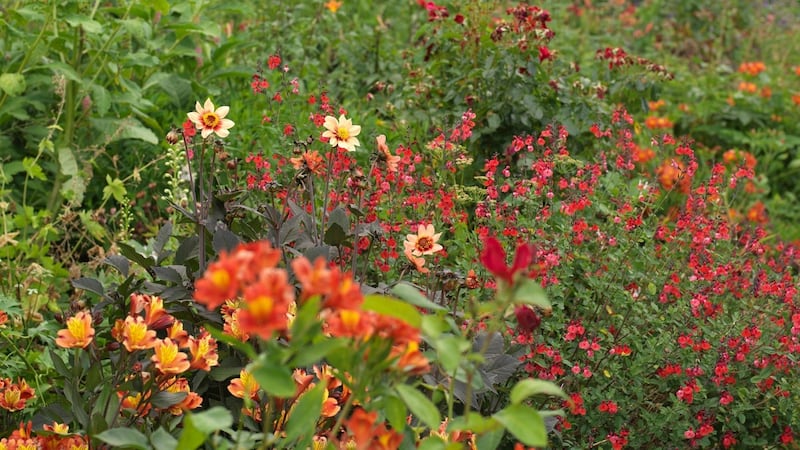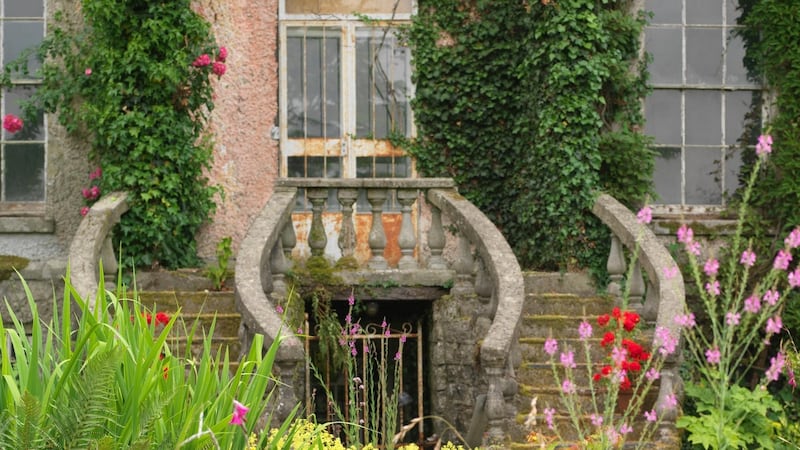There are some gardens that slowly seep into your soul to occupy a special place in your affections. Altamont in Ballon, Co Carlow, the former home of the late Corona North, is a shining example. It's not that its gardens are exquisitely maintained (in truth, while full of many magnificent mature specimen trees and shrubs, parts of the planting in its main OPW-managed gardens are recently beginning to look a little frayed around the edges). Or that it's filled with every sort of garden folly and ornament. Indeed, despite the fact it's been recently re-roofed, Altamont House itself, an endearing mix of 17th- and 18th-century architecture, is precariously perched on that delicate line between picturesque and irreversible decay.
Instead, I treasure this special place for its rare charm and magical atmosphere – a sort of horticultural fairy dust – that’s made me want to linger there ever since I first visited it as a teenager.
I love it for its giant and ancient beech trees and its surrounding meadowlands, for its almost quaint, sloping lawns, old rose beds and ornamental lake excavated during the famine years as well as for its wooded glen with paths that curl down to the majestic River Slaney. I also love it for the generations of interesting, talented, passionate gardeners – especially the inimitable Corona North – who have left their individual marks on it like fingerprints in time.
More recently, I prize it for its wonderful walled garden and nursery. Founded almost 20 years ago, it's managed separately to the rest of the 40-acre grounds by professional horticulturist and plantsman Robert Miller. Not only is this part of Altamont home to a 70-yard-long double herbaceous border packed to bursting with all sorts of lovelies – dahlias, phox, perennial geraniums, achillea, thalictrum, catmint, roses – and marvellously mature apple and medlar trees, but it's also home to one of Ireland's best garden centres. Not 'best' in the modern sense, where the plants almost inevitably play a sorry second to vast displays of garden furniture and lifestyle goods and a soulless, sprawling café. Instead I mean 'best' in the proper, old-fashioned sense, where every item for sale has been chosen by an expert plantsperson with a deep-rooted passion for gardening. This is the place to go to buy the choicest, healthiest roses (by his own admission, Miller is a rose fanatic), the most garden-worthy trees and shrubs and the loveliest of perennials and snowdrops (another of his great passions), the vast majority of them sourced from small-scale Irish growers.
Ultra-covetable specimens
On my last visit there, I spotted lots of ultra-covetable specimens for sale on its plant benches, from the golden sea thistle, Eryngium ‘Neptune’s Gold’ and the newly introduced peacock-blue and white variety of agapanthus called ‘Twister’, to a weeping form of gingko and a particularly lovely form of snowy mespil, Amelanchier ‘Ballerina’, ideally suited to a small garden. And yes, it’s also home to a small, thriving cafe. But the latter is so discreetly positioned and artfully screened by lush planting that it’s very easy to walk straight past it without knowing it’s there.

This special Irish garden centre is also the place to go to for oodles of free and expert gardening advice. Amiable, personable and easygoing but also a man on a mission, Miller is firmly of the opinion that educating people on all matters gardening is a fundamental part of his role as owner of Altamont Plants. "It's not just about selling plants but also about informing customers so that they make the very best choice. For example, I might get someone looking for Rose 'Dublin Bay'. Yes, it's a great-looking rose with large red flowers but it has no scent, so I'd always suggest the similarly-coloured but strongly-perfumed Rose 'Étoile de Hollande' as an alternative."
Miller's love of gardening extends far beyond the walls of Altamont: he's also the co-founder and chairperson of the hugely successful Carlow Garden Festival, now entering its 17th year, which runs from Friday, July 27th, to Monday, August 6th.
So from later this month, he'll be busy welcoming a host of luminaries from the world of British gardening to Co Carlow to give a variety of talks, walks, workshops and illustrated lectures including Fergus Garrett (author and head gardener of Great Dixter) and Chris Beardshaw (garden designer and this year's winner of RHS Chelsea Flower Show's 'Best in Show' award), both of whom will be speaking at Altamont Walled Garden on Friday, August 3rd.
Also taking part in this year's festival are Sarah Price, one of the world's most gifted garden designers; the British author and Times (UK) gardening columnist Stephen Anderton; the BBC Gardeners' World presenter, nursery woman and author Carol Klein; award-winning designer and Gardeners' World presenter Adam Frost; garden owner Alan Gray of East Ruston Vicarage Gardens in Norwich; and organic gardener, author and No-Dog proponent Charles Dowding.
Green-fingered experts
There will also be plenty of homegrown green-fingered experts taking part including Helen Dillon; plantsperson and rosarian Assumpta Broomfield; broadcaster and author Dermot O'Neill; Seamus O'Brien, author and head gardener of Kilmacurragh Botanic Gardens; Jimi Blake of Hunting Brook gardens; John Anderson, keeper of the gardens at Windsor Castle and Savill Gardens; Irish designers Fiann Ó Nualláin, Elma Fenton and Leonie Cornelius: author and Irish Garden columnist Shirley Lanigan; forest school expert Johanna Brown; and OPW tree officer Cormac Downey.
I'll also be taking part with a 'walk and talk' tour of the Carlow gardens of artist Philippa Bayliss (for details of all of the above, tickets of some of which will need to be booked well in advance, see carlowgardentrail.com).
As for Robert Miller, he’ll be the man in the shadows, quietly ensuring the event goes as smoothly and as seemingly effortlessly as possible. “Organising a festival of this size and complexity is exciting and challenging, especially as it gets larger with each passing year and expectations are constantly being raised. But the aim is always to entertain and educate the Irish gardening pubic, just as it was when we first started out.”
This week in the garden . . .
The prolonged heat and drought of recent months has been stressful for even large, well-established trees and shrubs. Signs include wilting, curling and yellowing leaves, premature leaf drop and even branch die-back as plants do what they can to survive. The good news is that most will recover as soil moisture levels gradually return to normal. But young trees and shrubs newly planted this spring are a very different story and will need to be regularly and generously watered (ideally 20 litres of water, or roughly two watering can’s worth around the base of the tree every second day, ideally in the evening, until autumn). Given the recent water crisis, try to use recycled household water to do this. While spreading a mulch of organic matter around the base of the tree or shrub (for example, lawn clippings or shredded bark) will also help to preserve moisture, it should only be used when the soil is already moist. It’s also important to keep mulches at least 15cm away from the trunk to minimise the risk of disease.

Keep deadheading plants every couple of days to ensure as long a flowering display as possible, using a sharp, clean secateurs to cut faded blooms and stems back to a point lower down the stem where there are either new lateral flower buds or leaves, or if this isn’t possible, then right back to the basal foliage of the plant. Good deadheading is an art that comes with regular practice, the aim being not only to encourage (when possible) the production of lots more new flowers but also to improve the general appearance of the plant.
While some species of plants have struggled with this summer’s high temperatures, record low rainfall and brilliant sunshine, ornamental shrubby salvias have been in their element. Colourful, long-flowering, drought-tolerant and pollinator-friendly, these versatile plants add great oomph to the summer and autumn garden and will continue blooming until the first harsh frosts. Many varieties are compact enough to grow quite happily in a pot or container (examples include the red-and-white flowering Salvia ‘Hot Lips’ and the grape-purple Salvia ‘Nachtvlinder’) while taller kinds such as Salvia Amistad (tall spikes of inky-blue/purple flowers and an average height and spread of 90cm x 60cm) look great in either a large pot or in a mixed border.
Dates for your diary
Friday July 27th- Monday August 6th, Carlow Garden Festival 2018: a host of garden experts will speak on a wide range of subjects in some of Ireland's loveliest gardens, see carlowgardentrail.com for details and to pre-book tickets.
Sunday July 29th (9.30am-5.30pm), Russborough Garden Show 2018: Russborough Gardens, Blessington, Co Wicklow, with plants, cut flowers and garden accessories sales, garden tours, garden advice, an open studio with members of the Irish Society of Botanical Artists, displays by the Beekeepers of North Kildare and guest speakers including organic kitchen gardener and blogger Nicky Kyle, members of the Flower Farmers of Ireland (FFOI) association Fionnuala Fallon and Britta Baranowsky, award-winning flower arrangers Karen Robinson and Maria Watchorn, and horticulturist Yvonne O'Connor, see russborough.ie.











